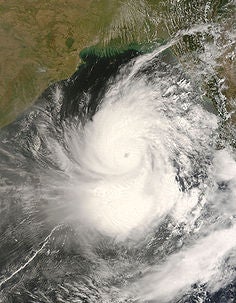
Michael provides weather services to many Everest expeditions as well as for other adventures around the globe from his company
Everest teams spend thousands of dollars to receive expert forecastthroughout the expedition. Many leaders are now weather experts inreading forecast maps and interpreting the data.
However, it is the weather professionals who monitor the data fromall around the world to feed these leaders the best informationpossible. In the end, each team makes their own decision based on data,observations and their own experience and instincts.
After all, a wrong decision can put lives at risks. Weather servicesis a major factor is selecting your team on an Everest climb.
The 1996 disaster on Everest was mostly blamed on a surprise storm thatmoved up the mountain. I asked Michael about that a couple of years agoand he told us that although this storm was a surprise to the climbersthat did not have access to forecast, a trained weather forecasterwould have seen (from forecast maps) a big storm coming in several daysprior to this tragedy.
Q: The famous 1996 Everest storm that claimed 12lives is said to have come up from the lower valley and rose ontoEverest. Was there anyway to forecast that event?
Severalyears ago I did look at some archived forecast maps for the day of theday storm on May 10, 1996, and forecast maps for several days beforethe storm. This was a typical strong storm pattern that can occur atEverest. There was a deep upper low pressure that was moving in fromthe north and west and this brought moderate precipitation and strongwinds. Estimated winds of over 100 knots. If I’m not mistaken afterthis tragedy that the Imax team, who was at a lower camp, decided tohire the first weather forecast for Everest and I believe they used aEuropean firm for the forecast
I wanted to see what has changed for 2010 and what the teams could expect. Once again, Michael shares his insights:
Q: We always hear about the Jet Stream ’sitting” ontop of Everest year-round. Does that change in a large way year to yearwith effects like El Nino or something else?
Actually duringsome El Nino years (like now) there is a strong southerly branch to thejet stream. What this means in the US is that California can gethammered with storms and this has been the case for this late winterand early spring so far. What this means for Everest is in some past ElNino’s the southerly branch of the jet stream can stay over Everest foran extended periods of time for strong winds. Perhaps well into May. Wewill see what happens this seasonQ: What is the lowest winds that climbers will accept for a summit bid?
I’m told by climbers that under 20 knots is good, under 30 knots is acceptable.Q: In terms of forecast accuracy, how would rate Everest predictions for wind accuracy?
When the jet stream is over Everest the forecast models do a good job.However the models tend to do poorly on the retreat of the jet stream.Many times the models want to have the jet stream exit the regionfaster than it actually does. Also when there is a big snow storm overEverest the models do very poorly. In fact the models do poorly ingeneral on predicting snowfall.Q: What is the forecast duration?
Generally 1 to 3 days the models for winds can be accurate.Q: Some forecasts are posted on the web, the so called grid forecasts. What are these and who accurate are they?
These grid forecasts take what the weather conditions will be for anexact latitude longitude coordinate. So the grid forecast will give youthe exact wind speed for the coordinates for Everest. I have found thatthe problem with these forecasts is if the forecast is off say 200miles or so that this can make for an extremely inaccurate forecast.For example. Let us say that the grid forecasts says Everest summitwinds will be 30 knots and the grid forecasts 70 knot winds severalhundred miles to the north of Everest. It is not uncommon for theactual forecast to be off by several hundred miles and the real timewinds can easily be at 70 knots over Everest. So the forecast of 30knot wind over Everest vs. real time winds of 70 knots is a bigproblem. Thus, it is important to get some weather professionalanalyzing the forecast models and explaining to expedition groups whatcan happenQ: Any new techniques for 2010?
Just continue to monitorthe tropics since over the last several climbing seasons there has beena tendency for storms to form in the Bay of Bengal and then move northtowards Everest. When this occurs this tends to bring copious amountsof snowfall and it did occur May 25, 2009Q: How is Everest weather different in the Spring compared to the Fall climbing seasons?
During the spring the major focus, besides the big storms out of theBay of Bengal, is when the jet stream shifts to the north which canmake for good summit wind conditions. Climbers want a heads up on this.For the fall climbing season one is looking for the retreat of themonsoon and associated precipitation. The retreat is to the south ofEverest.
Thanks Michael. I know we are all hoping for the weather window to open up as usual in mid may for a clear summit.
Climb On!
Alan
Arnette is a speaker, mountaineer and Alzheimer's Advocate. You can read more on his